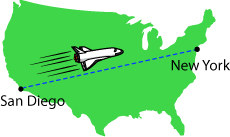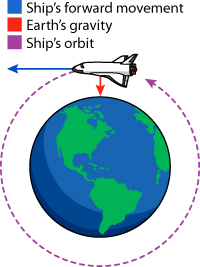How is a Low-Gravity Environment Created?

When we think of astronauts, we often picture people in suits floating in one spot in space. In reality, astronauts are usually in space ships that are in orbit around Earth, traveling extremely fast. Earth’s gravity pulls space ships down towards the ground, but since ships go as fast as 17,320 miles per hour (or 27,870 kilometers per hour) they stay in space. At this speed, you could travel from San Diego, California, to New York City in less than ten minutes.

As gravity pulls the space ship towards Earth, the speed of the ship keeps it moving forward, and these movements combine until the shuttle is traveling in a circle. As Earth is a sphere, travel in this circle lets astronauts fly around the Earth. So when someone is flying in orbit, they are basically falling all the way around Earth.
Since everything inside the spacecraft is falling at the same rate, there is very little gravity, and everything floats. This allows people to swim through the air, hold a hand-stand as long as they want without sweating, or have a slow-motion game of catch. This is called a microgravity environment because gravity still has an influence, but it is so small it is nearly impossible to measure.
On Earth, with a large gravity force, our leg and back muscles have to work to support the rest of our bodies. In orbit or in space, we weigh almost nothing, so our leg and back muscles get to take a vacation from their normal work load.
Read more about: Spaced Out Physiology
Bibliographic details:
- Article: Low-Gravity Environments
- Author(s): Dr. Biology
- Publisher: Arizona State University School of Life Sciences Ask A Biologist
- Site name: ASU - Ask A Biologist
- Date published: 8 Dec, 2011
- Date accessed:
- Link: https://askabiologist.asu.edu/how-low-gravity-environment-created
APA Style
Dr. Biology. (Thu, 12/08/2011 - 13:34). Low-Gravity Environments. ASU - Ask A Biologist. Retrieved from https://askabiologist.asu.edu/how-low-gravity-environment-created
Chicago Manual of Style
Dr. Biology. "Low-Gravity Environments". ASU - Ask A Biologist. 08 Dec 2011. https://askabiologist.asu.edu/how-low-gravity-environment-created
Dr. Biology. "Low-Gravity Environments". ASU - Ask A Biologist. 08 Dec 2011. ASU - Ask A Biologist, Web. https://askabiologist.asu.edu/how-low-gravity-environment-created
MLA 2017 Style

Astronauts training onboard the NASA KC-135 (vomit comet) experiencing weightlessness. The plane flies on a special path to produce periods of microgravity.
Be Part of
Ask A Biologist
By volunteering, or simply sending us feedback on the site. Scientists, teachers, writers, illustrators, and translators are all important to the program. If you are interested in helping with the website we have a Volunteers page to get the process started.

